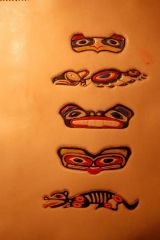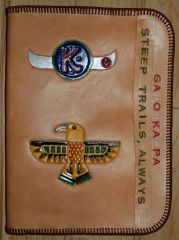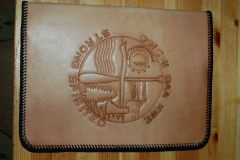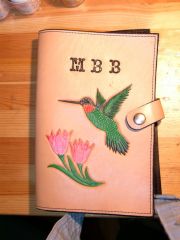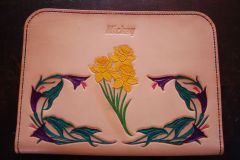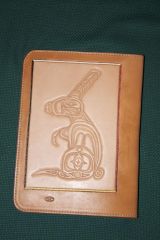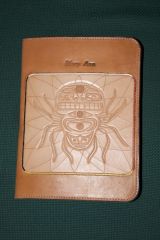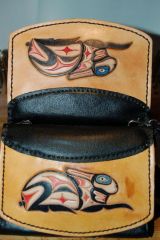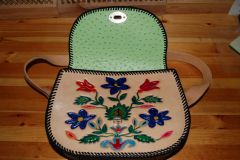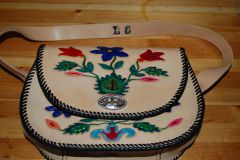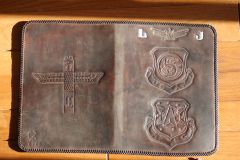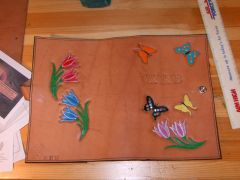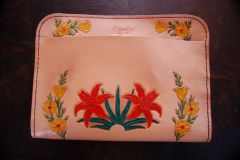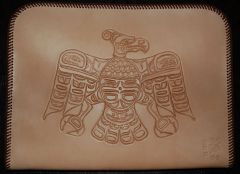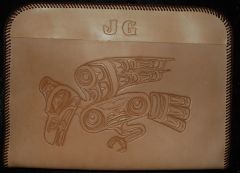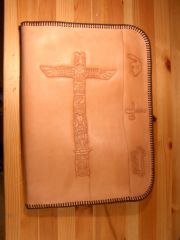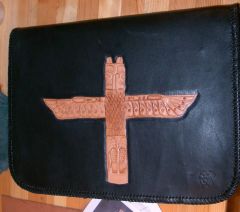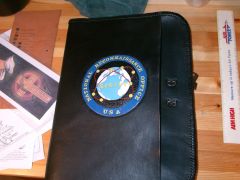-
Posts
607 -
Joined
-
Last visited
Content Type
Profiles
Forums
Events
Blogs
Gallery
Everything posted by BillB
-
TexasJack, It has been my experience that the only leather "coloration" that might be "stripped" would be a latex paint that sits on the surface of the leather with minimal adhesion. The dyes that I use are either Oil or Alcohol based and soak into the leather fibers, in some cases all the way through. In addition to dye on the leather there may also be a finishing coat to help protect and preserve the leather. In some types of finishing, this is a polyxxxx or plastic coat. Removal of any finishing coat will depend on its adherence to the leather fibers. If I were to be asked by someone to Re-Dye a leather item, I would first need to know if they were willing to throw the item away if things did not go right. I would also want to know if they would be willing to have the item dyed all black, since that will tend to cover most mistakes but not all. If they answered yes to both of these questions, then I might, just might: 1. try mixing an alcohol dye to match the original color of the purse using piece of scrap leather for a test item; 2. Take a small portion of that mix and dilute it; 3. Test it on the bottom of the purse to see if there are any adverse affects; 4. If this goes well, then apply a diluted version to the areas on the purse that need to be brought back and slowly try to get them back to the same intensity and shading of the rest of the purse while feathering the coats of diluted dye into the ares of original dye. 5. If none of that works, fill a bucket with Black dye and drop the purse in for a soaking. BillB.
-

What Kind Of Backing Is Used On This Caiman Skin Purse?
BillB replied to Shavonne's topic in Getting Started
Shavonne, The outside leather is either crocodile or simulated crocodile. In some areas crocodile is a protected animal and having the hide is illegal so simulated crocodile is used. The inside leather looks like fine quality suede. The one question you asked about stiffening the sides may have nothing to do with the type of leather use. There are a number of products one can by for the purpose of stiffening. This is usually a special paper product similar to thick poster board but made for this purpose. Tandy sells their version. It is intended to go between the outer layer, in this case the crocodile and the inner liner. So lets take the purse that is in your pictures. There are two large pieces of leather that make of the outer shell (crocodile) and the inner liner of suede. The inner liner needs to be thin and flexible so that it can be on the inside of the curves that form the bottom and the fold at the top. Two stiffeners to three stiffeners would be used, one on the front side above the curve at the bottom, one on the back side between the curve at the bottom and the curve at the top and one in the flap. Since there are all ready two pieces that will will be sewn together (outer shell and liner) the edges will have to be finished using a number of techniques to give the finished look and cover up the number of layers so the edge does not look like a piece of plywood. Just remember that any pockets that are sewn onto the liner will have to be done prior to attaching that sub-assembly to the outer shell. I hope this helps. BillB -
Curtis, I will try to help, but a lot of the question you ask you will have to answer for yourself. I have business cards in a leather folding card holder with two pockets, similar to a bi-fold wallet. The questions you ask on number of cards, two pockets versus one, and weight of leather all relate to how thick to you want this to be. Lets say you want to carry 25 cards in this card wallet. So take a stack of 25 cards and this begins to tell you the thickness you will end up with. Now add the thickness of the leather you want to use for the out shell and that would be on top and on the bottom of the stack. Now add to that the thickness of the leather or material you will use on the inside to make up the two pockets. I think you get the picture. Now for the weight of the leather. You mentioned that you want to tool the case. So here are some things to consider. The thick the leather, the deeper the tooling can be. If you use thin or light weight leather you run the risk of cutting through and will have to add a leather liner to give stability and strength back to the case. If you go to thick or heavy weight, the case gets thicker. The lighter the weight leather, the simpler the carving needs to be or it should just be embossed (no cutting of the surface). If you do carving, then every cut line weakens the leather and actually reduces it weight from a strength point of view. You did not mentioned if you were going to sew the case or lace the case, this should also be considered in your design. YOu might want to consider buying a leather case and disassembling it. This will show you how it is constructed as well as giving you a pattern. BillB
-
Johnny B. We all have had our first project. A journey always starts with the first step. My first step into leather crafts was in the 1950s. The journey has not been a continuous one. I got back into it in the 1970s and again in the 1990s. I plan on stay with it now since this is what I want to do after I retire this year. I must admit that having this site to share the journey with others has really helped. It has shown me so many different forms of leather crafts that I never knew existed. I have also fund that the folks on this forum are so willing to help others. I know this is a belated welcome but I hope you stay and join in. Bill B
-
JLSleather, Welcome to the forum. It's funny how the calling never goes away. When the bug bites it bites hard. There is one thing I would like to mention since you brought up the fact that you now have children. My best memories of my Grandfather center on his craft work (leather and Sea Grass). I tried to pass it to my children, and will try to do the same with my grandkids. So you might want to think about it as an investment in the future. Bill B.
-

How do I get my personal data into the systems
BillB replied to The King's topic in Feedback and Suggestions
El King, A belated welcome to the site. I hope Johanna's reply help solve your problem. I know how frustrating getting started in something new can be. I used to work on computers, and ever new system was a challenge. Not all of them are user friendly. If you stay a while, I am sure things will get worked out. If you are still having problems, please ask for help. Bill B. -
johnnysignor, Welcome to the forum. My father was in the Army Air Corp near the end of WWII. Those old patches are works of art. Some of their designs are making it back into USAF patches today. I look forward to seeing some of our work. I think you will find that this is a very interesting group of folks with lots of different interests. Again Welcome. BillB
-
From the album: Projects by BillB
© © leatherworker.net
-
From the album: Projects by BillB
© © leatherworker.net
-
From the album: Projects by BillB
© © leatherworker.net
-
From the album: Projects by BillB
© © leatherworker.net
-
From the album: Projects by BillB
© © leatherworker.net
-
From the album: Projects by BillB
I designed this Rabbit Totem for the back of my wife's Bi-Fold for weaving. The one with the Spider Totem on the front.© © leatherworker.net
-
From the album: Projects by BillB
My wife does weaving for a hobby so I designed this Spider Totem for her. The Spider is of course the Weaver. In the middle of the spider is a Beaver Totem for Industry.© © leatherworker.net
-
From the album: Projects by BillB
This is a Rabbit Totem I designed for my wife. Her maiden name is Haas which is German for hare (rabbit).© © leatherworker.net
-
From the album: Projects by BillB
© © leatherworker.net
-
From the album: Projects by BillB
© © leatherworker.net
-
From the album: Projects by BillB
© © leatherworker.net
-
From the album: Projects by BillB
© © leatherworker.net
-
From the album: Projects by BillB
© © leatherworker.net
-

Thunderbird Style Totem on back of Totem Pole Carvers Bi-Fold
BillB posted a gallery image in Our Leatherwork Galleries
From the album: Projects by BillB
© © leatherworker.net
-

Eagle Totem Style on Totem Pole Carvers Bi-Fold
BillB posted a gallery image in Our Leatherwork Galleries
From the album: Projects by BillB
© © leatherworker.net
-

Camp Kooch-i-ching Totem Pole on Directors Bi-fold
BillB posted a gallery image in Our Leatherwork Galleries
From the album: Projects by BillB
© © leatherworker.net
-

Thunderbird Totem Pole on NRO SIGINT Director Bi-fold
BillB posted a gallery image in Our Leatherwork Galleries
From the album: Projects by BillB
© © leatherworker.net
-
From the album: Projects by BillB
© © leatherworker.net



